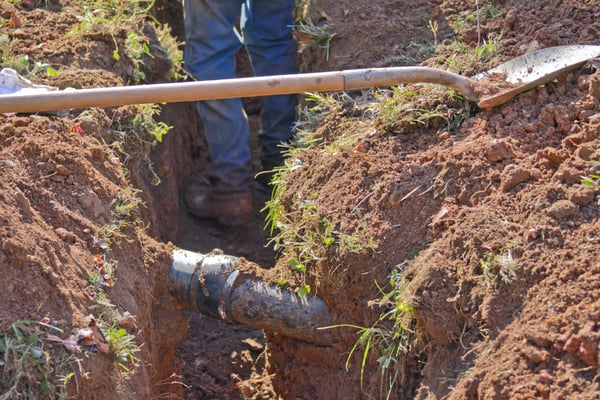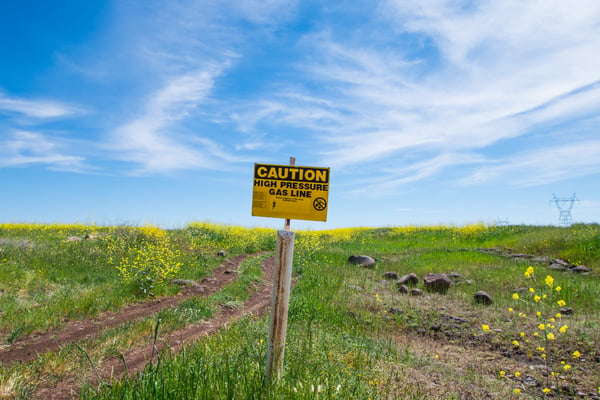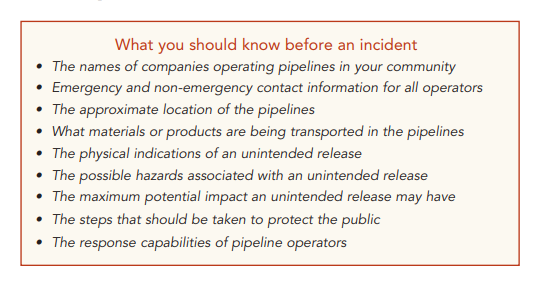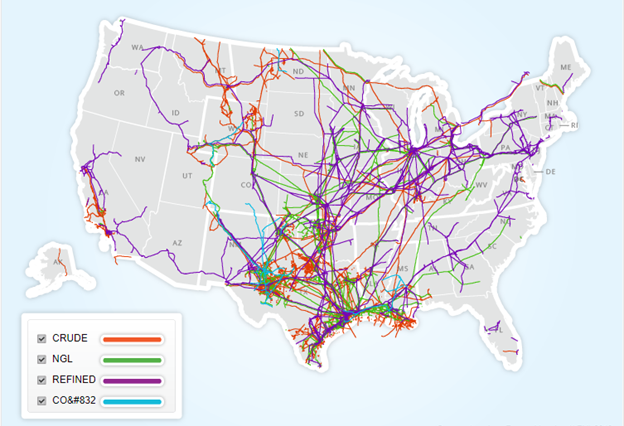
We recently had an uptick in queries about our pipeline hotline number monitoring services. And while we have been helping these types of customers for years, I am new to the industry, and decided to dig into why this is such an important part of operations for companies in the pipeline industry. And, as a marketer, I was also curious as to why interest had peaked for this particular service.
Pipeline 101
There is roughly 2.4 million miles of pipeline stretching across the United States. They transfer all sorts of liquids and gasses through a system of pipes, allowing us to do things like heat our homes and cook with gas, have access to running water at the turn of a faucet, and sanitarily flushing away our sewage.
These pipelines can be found almost everywhere. Much of our pipeline system is buried underground, but there are some above ground pipelines running thousands of miles across some of the country’s less densely populated areas.
Our longest above ground pipeline is the Rockies Express Pipeline which stretches from Meeker, CO to Clarington, OH.
US Liquids Pipelines, Source: American Energy Mapping (AEM)
Pipeline Regulations
As with any industry that has the potential to cause harm to people or the environment due to operations, pipelines are regulated by the U.S. government. The Department of Transportation (DOT), and more specifically, the Pipeline and Hazardous Materials Safety Administration (PHMSA), which is a division of the DOT are tasked with overseeing pipeline safety.
Why the Uptick in Queries?
One possible explanation for the uptick in our call queries is the potential enforcement of stricter pipeline integrity management process requirements. In July of 2018, there was an Advanced Notice of Proposed Rulemaking (ANPRM) issued—a statement asking for comments regarding safety measures for pipelines in response to population growth or “population class.”
An ANPRM is used by an agency to acquire public input on proposed changes to rules or regulations.
What Does This Mean for Pipeline Companies?
According to an article in The National Law Review, this proposed expansion of integrity management requirements would affect the actions that an operator of a gas transmission pipeline is required to undertake when population growth near a pipeline causes its “class location” to change.
Why This Matters To Pipeline Operators
Without getting into the technical nitty gritty of the details, “class locations” range from Class 1 to 4. “Class 1” refers to less densely populated/rural areas, and “Class 4,” are the most densely populated areas.
When a pipeline is designed, constructed, and operated, things like construction materials and maximum allowable operating pressure are taken into consideration. This differs based on “population class.”
This proposed regulation expansion is aimed at making sure that when a pipeline location class changes—the pipeline operator follows stricter guidelines. This could mean running different types of pipes, decreasing operating pressure, or developing stricter public safety protocols.
Why Is Hotline or Emergency Number Monitoring Such Serious Business?
There have been roughly 3,200 occurrences of “significant incident” natural gas pipeline events alone since 1987, reported by PHMSA/DOT.
A "significant incident" is any of the following:
- Fatality or Injury Requiring In-Patient Hospitalization
- $50,000 Or More In Total Costs, Measured In 1984 Dollars
- Liquid Releases of Five Or More Barrels (42 US Gal/Barrel)
- Releases Resulting in An Unintentional Fire or Explosion
In 2018, these were some of the reported incidents as of November 16:
- On January 8, a 12-inch pipeline was damaged and leaked 500 barrels (27,500 gallons) of gasoline in Eagan, MN. No injuries were reported; however gasoline flowed into the stormwater system.[2]According to Magellan Midstream Partners, the owner of the pipeline, a contractor the company hired accidentally struck and ruptured the pipeline that runs from Rosemount to Minneapolis.[3]
- On January 10, a pipeline in Pearl City, HIburst and leaked an estimated 500 gallons of fuel oil into two residents' yards.[4][5] The state Department of Health says a small amount of oil entered the stream.[6]
- On January 14, a natural gas pipeline ruptured, leading to a fire in Geismar, LA. No injuries or fatalities were reported.[7]
- On January 30, a crew using a boring drill hit a natural gas pipe in Arlington, TX. Escaping gas ignited and burned for over three hours. There were no injuries.[8]
- On January 31, a gas pipeline exploded and burned in Noble County, OH. There were no injuries.[9]
- On February 18, a 16-inch crude oil pipeline ruptured in Yukon, OK. Oil accumulated in a 7-acre private pond. About 84,000 gallons of crude were spilled.[10][11]
- On February 23, a house in a suburb of Dallas, TXexploded, killing a girl and injuring four others in her family. This followed a number of gas distribution line leaks in that area over the previous months. Atmos Energy crew then started large-scale replacement of gas lines in that area, resulting in at least 2,800 homes being without gas service for days to weeks. NTSB Investigators were sent to the area.[12]
- On March 3, a fallen electric wire from a utility pole caused a gas line to rupture and burn, in Wenham, MA. There were no injuries reported.[13]
- On March 21, a [Marathon] pipeline spilled about 42,000 gallons of diesel fuel, near Solitude, IN.[14]
- On May 10, a crude oil pipeline burst in Oklahoma City, OK, leaving a film of crude on a school playground, homes, and automobiles. At least 630 gallons of crude were released.[15]
- On May 14, a tractor crashed into a valve on an NGL pipeline in Mary Parish, LA, releasing a cloud of a blend of propane, butane, ethane, and natural gasoline. Residents and two schools were evacuated for several hours. There was no fire or explosion.[16][17]
- On May 23, a pipeline rupture and fire in Bienville Parish, LAforced at least 30 nearby residents to evacuate. There were no injuries.[18]
- On June 7, a 36-inch natural gas transmission pipeline exploded and burned, near Wheeling, WV. There were no injuries. The pipeline went into service in January 2018. Shifting land was identified as the cause.[19][20][21]
- On June 14, a gas pipeline in Tulsa, OKwas damaged by a tractor. A firefighter and four Oklahoma Natural Gas workers were injured in the explosion and fire that followed the incident. An initial report said one of the injured was a bystander.[22]
- On June 15, a Southern Star Central Natural Gas pipeline exploded outside Hesston, KS, sending flames shooting 75 to 100 feet into the sky[23]
- On June 19, a Sunocopipeline leaked more than 33,000 gallons of gasoline into a creek, near Philadelphia, PA. PHMSA said it first learned of the spill on the evening of June 19 from a “private citizen” who reported a petroleum odor at Darby Creek. About two-thirds of the spill was recovered.[24]
- On August 1, a series of gas pipeline explosions injured seven pipeline workers and firefighters in Midland County, TX. One injured worker later died. They were responding to a leak report.[25]
- On September 6, a 6-inch Dominion Energygas gathering pipeline burned, near Clarksburg, WV. Lightning was suspected of hitting the pipeline.[26]
- On September 7, a Buckeye Partnerspipeline ruptured in Decatur, IN, spilling about 8,000 gallons of jet fuel into the Mary’s River (Indiana and Ohio).[27]
- On September 10, a 24-inch Energy Transfer Partnersgas transmission pipeline exploded and burned, in Center Township, Beaver County, PA. One home, two garages, and six steel high-tension power line towers were destroyed, but no injuries were reported. The pipeline had been operating for one week before the failure. Earth movement was suspected as the cause.[28]
- On September 13, Massachusetts gas explosionsdestroyed 40 homes, killed one person, and 21 were sent to the hospital. [29] [30]
Data Source for this section.

Basic Pipeline Public Safety
As you can see, pipeline safety is important. Rule of thumb; if you see something odd—say something. It could save lives and reduce negative effects on the environment. And, do your due diligence before you dig. Know what types of pipelines are running through your yard before you start excavating.
How Do You Report Emergencies or Potential Emergencies?
Pipeline companies are required to have signage attached to their pipeline which tells you about the product running in the pipe, the pipeline operator who is responsible for maintaining the pipeline, and a 1-800 number listed for you to call to report potential problems. This number should be answered 24/7/365.
If you don’t see a marker or number to call, and aren’t aware of who provides local services for a particular pipeline, then it is recommended that you call 911 to report the incident.
Pipelineawareness.org recommends that you know a few things to help you keep an eye out for potential occurrences before they happen:

Overall Takeaway
- Operating conscientiously is an expectation of the modern-day business. And, when it comes to safety and the environment, pipeline companies—especially those carrying hazardous materials—will continue to be heavily monitored by the government, to try and ensure that operators are choosing safety over cost.
- As community members, we need to play our part also. It is our duty to alert someone when things don’t seem right. And, with the miles and miles of pipeline out there, it is pretty safe to assume that maintenance details slip through the cracks, unnoticed, every now and again.
- Diligence on all sides, is the key to making sure that our modern-day infrastructure is a success.
Article Sources:
• https://www.natlawreview.com/article/pipeline-safety-update-issue-no-141-september-17-2018
• http://www.pipeline101.org/Where-Are-Pipelines-Located
• https://fedsteel.com/our-blog/five-longest-pipelines-world/
• https://www.regulationwriters.com/regulatory_glossary/
•https://en.wikipedia.org/wiki/List_of_pipeline_accidents_in_the_United_States_in_2018






